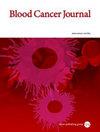Neutrophil-to-Lymphocyte ratio as surrogate for JAK2V617F suppression and event-free survival in polycythemia vera.
IF 11.6
1区 医学
Q1 HEMATOLOGY
引用次数: 0
Abstract
Chronic systemic inflammation is a key driver of polycythemia vera (PV) progression, but the immunomodulatory effects of current treatments remain poorly defined. The neutrophil-to-lymphocyte ratio (NLR) is an accessible biomarker of systemic inflammation proven in other contexts, but its role in monitoring PV disease activity has not been established. Using data from three of the largest PV clinical trials, we evaluated the effects of PV therapies on NLR and its relationship with molecular response and clinical outcomes. In 404 hematocrit-controlled patients from the ECLAP study, hydroxyurea (HU) failed to significantly lower NLR (p = 0.11) due to the parallel declines in ANC and ALC. Neither leukocyte counts nor NLR were significantly reduced by phlebotomy in ECLAP patients treated without cytoreductive therapy. In contrast, the Low-PV study showed that while phlebotomy tended to increase NLR, low-dose ropeginterferon alfa-2b (Ropeg) significantly reduced NLR (-18.2% and -36.3% in patients with low and high baseline NLR, respectively) by suppressing ANC rather than lymphocytes. NLR reduction correlated with the primary Low-PV endpoint (p = 0.021) and reduction of JAK2 variant allele frequency (VAF) [1]. The PROUD-PV/CONTINUATION-PV study confirmed the superior effect of Ropeg over HU, with a significantly greater NLR reduction at 60 months (-56.5% versus -33.6%, respectively, p = 0.019) in patients with high baseline NLR. Moreover, NLR reduction was associated with decreased JAK2V617F VAF (p < 0.0001) and improved event-free survival (p = 0.010). These findings identify NLR as a dynamic biomarker of treatment response and prognosis in PV and support its incorporation into routine monitoring.中性粒细胞与淋巴细胞比率作为真性红细胞增多症患者JAK2V617F抑制和无事件生存的替代指标。
慢性全身性炎症是真性红细胞增多症(PV)进展的关键驱动因素,但目前治疗的免疫调节作用仍不明确。中性粒细胞与淋巴细胞比率(NLR)是一种可获得的全身性炎症的生物标志物,已在其他情况下得到证实,但其在监测PV疾病活动中的作用尚未确定。利用三个最大的PV临床试验的数据,我们评估了PV治疗对NLR的影响及其与分子反应和临床结果的关系。在ECLAP研究中404例红细胞压差控制的患者中,由于ANC和ALC的平行下降,羟基脲(HU)未能显著降低NLR (p = 0.11)。在未接受细胞减少治疗的ECLAP患者中,白细胞计数和NLR均未因静脉切开术而显著降低。相比之下,low- pv研究显示,虽然放血倾向于增加NLR,但低剂量Ropeg干扰素α -2b (Ropeg)通过抑制ANC而不是淋巴细胞显著降低NLR(基线NLR低和高的患者分别为-18.2%和-36.3%)。NLR的降低与主要的Low-PV终点(p = 0.021)和JAK2变异等位基因频率(VAF)的降低相关。PROUD-PV/ continue - pv研究证实了Ropeg优于HU的效果,在基线NLR高的患者中,60个月时NLR降低明显更大(分别为-56.5%和-33.6%,p = 0.019)。此外,NLR降低与JAK2V617F VAF降低(p < 0.0001)和无事件生存期改善(p = 0.010)相关。这些发现确定NLR是PV治疗反应和预后的动态生物标志物,并支持将其纳入常规监测。
本文章由计算机程序翻译,如有差异,请以英文原文为准。
求助全文
约1分钟内获得全文
求助全文
来源期刊

Blood Cancer Journal
ONCOLOGY-
CiteScore
16.70
自引率
2.30%
发文量
153
审稿时长
>12 weeks
期刊介绍:
Blood Cancer Journal is dedicated to publishing high-quality articles related to hematologic malignancies and related disorders. The journal welcomes submissions of original research, reviews, guidelines, and letters that are deemed to have a significant impact in the field. While the journal covers a wide range of topics, it particularly focuses on areas such as:
Preclinical studies of new compounds, especially those that provide mechanistic insights
Clinical trials and observations
Reviews related to new drugs and current management of hematologic malignancies
Novel observations related to new mutations, molecular pathways, and tumor genomics
Blood Cancer Journal offers a forum for expedited publication of novel observations regarding new mutations or altered pathways.
 求助内容:
求助内容: 应助结果提醒方式:
应助结果提醒方式:


